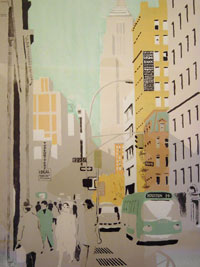Sweeney Todd. Tim Burton’s two-hour-long film version of Stephen Sondheim’s greatest musical is a devastatingly concise, horrifically bloody exercise in neo-Gothic naturalism from which all the stage-specific presentational elements of the original production have been trimmed away. The results are effective in the extreme, not least because of Johnny Depp’s cold, hard, unrelenting performance of the title role. No, the singing isn’t great, but it’s still the best film of a Broadway musical ever made, Cabaret included (TT).
Archives for January 2008
TT: Almanac
 “The clock by the corner pointed to the hour of three, and Jesse Fineman had wanted to see him any time that afternoon in his office off Broadway. First he passed the restaurants on the corss street west and the windows of secondhand shops filled with bronze statuary and Arab pistols and all sorts of other articles which he could not imagine anyone’s wanting to buy. Then there were the small hotels with marble fronts and with palm trees in the lobbies. Then there were the subway entrances where the Interborough and the B.M.T. entwined beneath the street, and then Times Square. Broadway was always shabby in the afternoon. The electric signs stood nakedly against the sky like the frames of elaborate fireworks displays. Although Times Square was crowded, it all seemed half-asleep. The picture houses and the drugstores and the newsstands never seemed to try in the afternoon.
“The clock by the corner pointed to the hour of three, and Jesse Fineman had wanted to see him any time that afternoon in his office off Broadway. First he passed the restaurants on the corss street west and the windows of secondhand shops filled with bronze statuary and Arab pistols and all sorts of other articles which he could not imagine anyone’s wanting to buy. Then there were the small hotels with marble fronts and with palm trees in the lobbies. Then there were the subway entrances where the Interborough and the B.M.T. entwined beneath the street, and then Times Square. Broadway was always shabby in the afternoon. The electric signs stood nakedly against the sky like the frames of elaborate fireworks displays. Although Times Square was crowded, it all seemed half-asleep. The picture houses and the drugstores and the newsstands never seemed to try in the afternoon.
“Nothing Jeffrey saw had changed much from the way he first remembered it. There was the same cynicism, the same disregard for sobriety, the same combined efforts of millions of people to escape from what troubled them. It was all pathetic like every fallacy, but at least it was not new.
“‘Plenty of seats in just a minute,’ the men in the horizon-blue uniforms were saying. ‘The main picture will be over in three minutes. Seats now only in the mezzanine.’
“The police whistles were blowing, crowds were streaming solidly across the street. It was all more permanent than Fifth Avenue–timeless, too complicated to understand, but then, there was no reason to understand it.”
John P. Marquand, So Little Time
CD
The Complete Louis Armstrong and the Dukes of Dixieland (Essential Jazz Classics, three CDs). The greatest jazz musician of the twentieth century teamed up with a banjo-and-tuba Dixieland septet in 1959 to knock off an early-stereo LP of very standard New Orleans standards. It should have been an infallible recipe for ennui, but Armstrong caught fire, and the result was one of the liveliest and most exciting albums of his middle age, followed a year later by a similarly satisfying sequel. Both albums have now been reissued in their entirety on this three-CD set, augmented by twenty alternate takes. Take a taste of “Bourbon Street Parade” and see if it doesn’t make you feel like cooking up some of that good ol’ red beans and rice (TT).
CD
The Mills Brothers: The 1930s Recordings. Long before the Mills Brothers were a middle-of-the-road quartet known for their close-harmony ballads, they were a smooth-toned, hipper-than-hip vocal group billed as “four boys and a guitar” that Lester Young once wittily described as “the best saxophone section I ever heard.” Their first 116 recordings, pristinely remastered by John R.T. Davies, have been collected in this low-priced five-CD set that abounds with musical riches, including guest appearances by Louis Armstrong and Bing Crosby. The listening is easy, but the swinging is hard (TT).
FILM
The Trip to Bountiful. Peter Masterson’s 1985 film of Horton Foote’s 1953 TV play isn’t quite as good as the stage version–Geraldine Page’s Oscar-winning star turn is a bit too fluttery and flirtatious–but it still captures the essence of Foote’s deeply moving tale of an old woman trapped in a Houston apartment who longs to see her home town once more before she dies. If you’re anywhere near Chicago when the Goodman Theatre’s revival opens in March, make every effort to see it. Otherwise, you won’t go far wrong by renting this DVD (TT).
TT: When an artist retires
In today’s Wall Street Journal “Sightings” column, I reflect on Alfred Brendel’s recent announcement of his plans to retire from public performance next year. At what point should an aging artist call it quits–and what responsibility do critics have to call time?
Some excerpts:
I treasure my memory of the last gig of the jazz saxophonist Benny Carter, who was born in 1907, cut his first records in 1928 and kept on playing until 1995, when I had the good fortune to hear him in New York, eight years before his death. He was still playing well–and he knew it. “I play the same way now that I did when I was 23, so I don’t think age has anything to do with it,” he told Peter Keepnews of the New York Times.
But the performer, unlike the creator, is as much athlete as artist, and thus is slave to the flesh. Sooner or later he must face, like the oven bird of Robert Frost’s poem, the problem of “what to make of a diminished thing.” Some performers, like Horowitz and John Gielgud, solve that problem bravely and resourcefully, balancing the intensified insight of maturity against the physical decline that gradually erodes their mechanical skills, and manage to go out on a high note. Others, like Rudolf Nureyev and Arturo Toscanini, hang on too long, leaving their fans with memories they’d rather not have….
Read the whole thing here.
TT: Getting crazy in Milwaukee
Today’s Wall Street Journal drama column is devoted in its entirety to a review of the Milwaukee Repertory Theater’s revival of Alan Ayckbourn’s The Norman Conquests. Here’s a sample.
* * *
 Alan Ayckbourn, the most prolific and successful playwright since Shakespeare, has written 71 plays, only six of which have been seen on Broadway. Why is he so popular in Great Britain and so comparatively little known over here? Part of the problem is that most of his plays are more serious than they look. He uses the dizzy language of farce to say dark things about the sorrows and disappointments of middle-class life, and the harder you laugh at his hapless characters, the more your heart goes out to them.
Alan Ayckbourn, the most prolific and successful playwright since Shakespeare, has written 71 plays, only six of which have been seen on Broadway. Why is he so popular in Great Britain and so comparatively little known over here? Part of the problem is that most of his plays are more serious than they look. He uses the dizzy language of farce to say dark things about the sorrows and disappointments of middle-class life, and the harder you laugh at his hapless characters, the more your heart goes out to them.
The good news is that many of Mr. Ayckbourn’s plays are seen with fair frequency both Off Broadway and in regional theaters. Alas, the latter fact has not yet come to the attention of Variety, which ran a piece last month saying that he was “unrecognized in the U.S.” without adding that one of his most ambitious and masterly efforts, “The Norman Conquests,” is now being performed by the Milwaukee Repertory Theater–for the second time in that company’s history. London’s Old Vic is reviving “The Norman Conquests” next fall, but the Rep, to the best of my knowledge, is the only professional theater company in America to have done so since it ran on Broadway 32 years ago. I’m happy to report that their new production is an uproariously funny, wholly successful piece of work.
Mr. Ayckbourn’s method can be seen at its maddest in the 1973 triptych that established him as England’s number-one hitmaker. The three plays that make up “The Norman Conquests” feature the same six characters and take place during the same weekend, but are set in three different parts of the same country house, the dining room (“Table Manners”), the sitting room (“Living Together”) and the garden (“Round and Round the Garden”). While the plays are written so that each one makes sense when viewed individually, you learn in the course of watching all three that the title character (played by Gerard Neugent) is not only carrying on extramarital dalliances with a youngish woman named Annie (Finnerty Steeves) and Sarah, her bossy sister-in-law (Laura Gordon), but also canoodling with his estranged wife Ruth (Deborah Staples), Annie’s older sister.
In addition to letting us see the action from a variety of perspectives, this brilliantly ingenious conceit makes it possible for Mr. Ayckbourn to turn up the comic heat on his characters all the way to the boiling point….
* * *
Read the whole thing here.
TT: Almanac
“Father Time is not always a hard parent, and, though he tarries for none of his children, often lays his hand lightly on those who have used him well; making them old men and women inexorably enough, but leaving their hearts and spirits young and in full vigour. With such people the grey head is but the impression of the old fellow’s hand in giving them his blessing, and every wrinkle but a notch in the quiet calendar of a well-spent life.”
Charles Dickens, Barnaby Rudge
